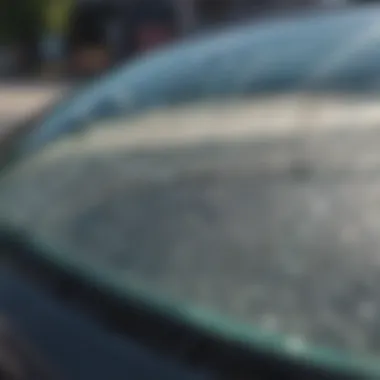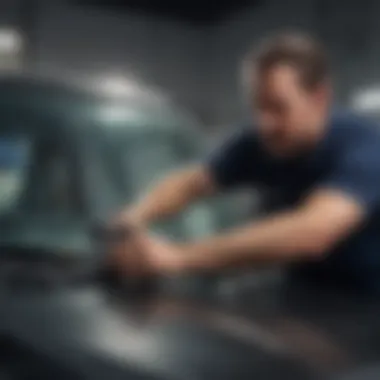Understanding the Cost to Repair Small Windshield Cracks


Intro
Windshield damage is a common issue faced by vehicle owners. A small crack may seem insignificant, yet it can compromise structural integrity and visibility. This article serves as a thorough guide for understanding the costs and processes involved in repairing a small crack in a windshield. By grasping the complexities of the repair process, readers can make knowledgeable choices regarding repair options and insurance coverage.
Coverage Options
When addressing windshield repairs, it’s essential to consider your insurance coverage. The level of coverage you have can significantly affect out-of-pocket costs. Understanding the types of coverage available is crucial for vehicle owners.
Types of Coverage Available
- Comprehensive Coverage: Often includes repairs for non-collision incidents, such as windshield damage. This coverage usually has lower deductibles, making it advantageous when dealing with small cracks.
- Collision Coverage: While primarily for accident-related repairs, some policies may cover windshield cracks occurring during a collision. However, this typically involves higher deductibles.
- Glass Coverage: Specific policies focus entirely on glass repairs or replacements. This can be an ideal option if you frequently encounter windshield damage.
Liability Coverage Explained
Liability coverage generally does not cover windshield damage. Instead, it protects against damages to other vehicles or property in an accident. Vehicle owners who primarily rely on liability coverage may find themselves facing higher repair costs following windshield damage.
Key Considerations
When selecting insurance and exploring repair options, several factors require careful assessment.
Factors to Assess When Choosing Insurance
- Deductibles: Higher deductibles can mean lower premiums but also larger out-of-pocket expenses when repairs are needed.
- Claim Limits: It’s essential to know the claim limits of your insurance policy. Some policies offer maximum payouts per incident, which can影响 overall coverage effectiveness.
- Reputation of Repair Services: Researching repair services' credentials and reviews can influence the quality of work done on your windshield.
Understanding Policy Limits
Every insurance policy has specific limits defining what is covered. Familiarize yourself with these limits to avoid unexpected costs. Some policies may not fully cover multiple claims within a short timeframe.
"Knowing your insurance coverage and policy limits can save you significant time and money when dealing with windshield repairs."
Understanding Windshield Cracks
The significance of understanding windshield cracks lies in their direct impact on vehicle safety and aesthetics. Cracks can compromise visibility and the structural integrity of the glass, posing risks for the driver and passengers. Recognizing the type and cause of a crack is paramount for determining the best course of action—whether that be repair or replacement. Each type of crack comes with its unique characteristics, which can influence the repair process, costs incurred, and the necessity of professional help.
Identifying cracks early and understanding their characteristics can save vehicle owners from more extensive damages. This section highlights critical elements such as types of cracks, their causes, and why knowledge about them is essential for making informed decisions related to repairs.
Types of Windshield Cracks
Star Break
Star breaks are characterized by a central point from which multiple cracks radiate outward like the points of a star. This type often results from road debris striking the windshield. Star breaks can be somewhat easy to repair, provided they are small. Thus, they offer a beneficial opportunity for quick repairs, minimizing the need for windshield replacement. On the downside, if ignored, they can expand and lead to a total replacement, which is a more costly solution.
Chip
Chips are small indentations in the glass caused by the impact of stones or sharp objects. They are typically less serious than long cracks, as they do not affect visibility much. Chips can often be repaired efficiently at low costs, making them a favorable issue to address. The challenge is that if not repaired promptly, they can grow into larger cracks, leading to increased repair expenses.
Long Crack
Long cracks can measure several inches in length and often extend across the windshield. They impact visibility significantly and can occur due to sudden temperature changes or impact from larger objects. Their repair is usually more challenging and may be limited if they are too long, sometimes resulting in the necessity for full replacement. Thus, understanding the potential risks associated with long cracks helps in prioritizing timely repairs.
Edge Crack
Edge cracks are located within two inches of the windshield's edge and may pose unique challenges. They can spread quickly, mainly if not addressed immediately. Their proximity to the edge makes them more vulnerable to stress and temperature changes. Though they may be small, their potential to worsen makes it essential to evaluate them as soon as they appear. This aspect makes edge cracks a critical subject for discussion in the context of repairs and safety.
Causes of Windshield Cracks
Road Debris
Road debris is a primary cause of windshield damage. It includes rocks, gravel, and other objects that can strike the windshield while driving. This factor is important to consider because the type of debris and the speed at which it hits the glass directly affect the severity of the damage. Repairing chips or cracks caused by road debris is often straightforward, leading to a better overall repair cost.
Temperature Changes
Temperature changes can induce stress on the windshield glass, causing it to expand and contract. This fluctuation can lead to cracks forming, especially in areas with extreme weather conditions. Understanding how temperature affects the glass helps vehicle owners appreciate the risks involved in drastic weather changes, especially following a recent repair. Hence, addressing these issues may be crucial for long-term windshield maintenance.


Impact Force
Impact force from objects like hail, tree branches, or accidents can create cracks. The severity depends on the force of the impact, with larger impacts causing more significant damage. Evaluating the force behind a crack can help in deciding whether to repair or replace the windshield, influencing the overall cost and process choices.
Properly assessing and understanding these factors can enable vehicle owners to take proactive measures in maintaining their windshields.
By grasping these aspects of windshield cracks and their causes, vehicle owners can enhance their approach to maintenance and repairs. Making the right choices can lead to safer driving conditions and minimize potential expenses associated with severe windshield damage.
Assessment of Damage
Assessing the damage is a crucial step when addressing windshield cracks. Understanding the severity and type of damage helps vehicle owners make informed decisions. Proper assessment can save time and money in repairs and impact future safety. Ensuring that a crack is not too extensive for a simple fix is essential.
Determining Repairability
Crack Length and Depth
Crack length and depth are fundamental factors in determining if a repair is feasible. A shorter crack, generally under six inches, is often easier to repair. Depth is also crucial; digs that do not penetrate the glass layer might be repairable. Deep cracks may compromise the windshield’s integrity. This characteristic makes it crucial to measure cracks accurately. A depth exceeding 1/8 inch likely requires replacement instead of repair.
Advantages of Crack Length and Depth:
- It directly influences cost-effectiveness.
- Helps in achieving safety and stability of the windshield.
Location on Windshield
The crack's location plays an important role too. Cracks near the edges are usually more serious. They are prone to spreading, leading to further complications. On the other hand, cracks situated within the driver’s line of sight can impair visibility. Concerns related to location speak to overall driving safety.
Key Characteristics of Location:
- Determines potential for future damage.
- Influences the method of repair or replacement, shaping overall costs.
Implications for Driving Safety
Examining the implications of cracks is vital for driving safety. A compromised windshield can affect structural integrity. Cracks can reduce the windshield's capacity to provide protection during accidents. This is why understanding implications is not just about costs. It’s about ensuring safety for the driver and passengers.
Unique Features of Driving Safety Implications:
- Informs decision-making regarding repairs and replacements.
- Highlights the correlation between well-maintained windshields and overall vehicle safety.
Professional Inspection
Choosing a Qualified Professional
Selecting a qualified repair professional is of utmost importance. An effective repair not only fixes visible issues but also ensures long-term safety and durability. A skilled technician performs comprehensive assessments, guaranteeing precise diagnoses. This choice is often more beneficial than attempting DIY repairs.
Key Characteristics of Choosing a Professional:
- Experienced professionals understand the nuances of various damages.
- Their expertise often leads to more reliable and long-lasting repairs.
Importance of Assessing Damage
Assessing damage through professional services is a critical step. It unveils underlying issues that may not appear obvious to the untrained eye. This process helps in understanding the full impact of the crack. A thorough evaluation may include checking for related issues around the windshield area, which can affect repairs.
Unique Aspects of Damage Assessment:
- Provides a clear picture and understanding of repair needs.
- Forms the base for an effective repair strategy and future maintenance plans.
By taking these assessment steps seriously, vehicle owners can ensure their safety and the longevity of their windshields.
Repair Options Available
Understanding the repair options available for a small crack in a windshield is crucial for vehicle owners. It influences not just the ultimate cost of fixing the damage but also safety on the road. Choosing the right repair option can impact the structural integrity of the windshield and help to prevent further issues down the line.
There are generally two primary categories of repair options: DIY repair kits for those who want to handle repairs independently and professional repair services for those preferring expert assistance. Both options come with their own advantages and considerations.


DIY Repair Kits
Components of DIY Kits
DIY repair kits typically include resin, a syringe for application, and a curing film. These components are designed specifically for filling small cracks and chips. A standout feature of these kits is their convenience. Vehicle owners can perform repairs at home without needing to schedule an appointment. However, the quality of materials can vary significantly among different kits. Some may provide a satisfactory result, while others might not bond properly with the windshield, leading to potential future problems.
Effectiveness of DIY Solutions
The effectiveness of DIY solutions often depends on the skill of the individual using the kit. A well-executed repair can restore structural integrity and minimize visibility of the crack. However, not all DIY repairs yield professional results. In some cases, improper application can leave the crack more visible or lead to further splitting. Thus, while DIY options can save money and time, they require careful attention to detail to be truly effective.
Cost of DIY Kits
Pricing for DIY kits generally ranges from $10 to $30. This low cost is a significant factor making them attractive to many vehicle owners. However, potential drawbacks include the risk of inadequate repair. If a DIY kit fails, the owner might face higher expenses down the line when needing to engage a professional. It’s also important to consider the value of one's time and effort when evaluating the overall cost of a DIY approach.
Professional Repair Services
Process of Professional Repairs
Professional repair services typically follow a specific process. Technicians assess the damage first, then clean the area before injecting resin into the crack. After curing the resin, they complete the repair by polishing the surface. This process not only ensures a more reliable fix but also saves the vehicle owner from the hassle of attempting a repair themselves. Professional repairs can restore both visibility and structural integrity effectively.
Factors Influencing Costs
Several factors influence the cost of professional repairs. Geographic location, the extent of the damage, and the specific service used all play a role. Generally, professional repairs may range from $50 to $150, depending on these factors. It’s critical for owners to seek estimates from multiple service providers to ensure they receive a fair price, especially if they think their repair is straightforward.
Warranty and Guarantees
A noteworthy advantage of opting for professional repair services is that many include warranties or guarantees for their work. This means that if an issue arises shortly after the repair, they will address it without additional costs. This can offer peace of mind to vehicle owners, ensuring that their investment in repair is safeguarded. In contrast, DIY repairs typically do not offer such assurances.
Cost Considerations for Repairs
Understanding the financial aspect of filling a small crack in a windshield is vital for vehicle owners. This section delves into the considerations related to the cost of repairs, including the price range for services and the potential impact of insurance coverage.
Average Repair Costs
Pricing Range for Various Repairs
The pricing for filling a small crack in a windshield can vary significantly. Generally, drivers can expect to pay between $50 and $150 for a basic repair. However, this range is influenced by several factors such as location, service provider, and the extent of the damage.
Higher-end repairs, especially those requiring specialized tools or materials, may cost up to $250. Maintaining pricing transparency is essential, allowing customers to make informed choices while considering various options.
Prospective clients should compare estimates from different providers. Many shops offer free inspections, which can lead to a more accurate understanding of potential costs. This encourages a beneficial approach for customers, as they can select a reasonably priced service without compromising quality.
Factors Impacting Cost Variation
Several elements can lead to variations in repair costs. The most significant ones include:
- Location of the repair shop: Urban areas may have higher labor costs than rural locations.
- Type of repair: More complex damages, such as long cracks, may require additional work.
- Materials used: The choice between OEM or aftermarket products can affect overall costs.
These factors contribute to the difficulty of identifying a fixed price for repairs. For instance, repair shops that utilize advanced technology or offer longer warranties may charge higher prices. Despite the costs, opting for such services can lead to higher customer satisfaction and long-lasting repairs.
Insurance Coverage and Windshield Repairs
Having a solid understanding of how insurance covers windshield repairs can influence financial decisions immensely. This section explores the intricacies of comprehensive coverage and how it plays a role in managing repair costs.
Understanding Comprehensive Coverage
Comprehensive insurance generally covers damages caused by incidents other than collisions, including windshield chips and cracks. Many people find this to be a beneficial aspect of their policy. Understanding this aspect is crucial for vehicle owners.
Accidents often come with unpredictable expenses, and comprehensive coverage can alleviate some of this burden. However, not all policies are the same. Policyholders should examine their contracts to see how their specific plans handle windshield repairs.
Claims Process for Windshield Repair
The claim process for windshield repair can seem daunting; however, it is usually straightforward. First, vehicle owners must report the damage to their insurance provider. They will guide clients on whether to go through a specific service network.


Despite the ease of the claims process, the timeline for repairs can vary. Some providers may require assessments from preferred repair shops, leading to delays. This highlights the importance of understanding the terms when selecting coverage.
Potential Out-of-Pocket Costs
Even with insurance coverage, some expenses often fall to the vehicle owner. For instance, deducible amounts can apply, meaning owners might need to pay a portion of the repair costs themselves. Between deductibles and potential policy restrictions, knowing these possible out-of-pocket costs is wise.
It is important for vehicle owners to budget for such expenses, as they can affect the overall decision-making process for repairs. By anticipating these costs, individuals can better prepare for any financial implications that arise from windshield damage.
Preventive Measures
Preventive measures play a significant role in maintaining the integrity of a windshield. Taking proactive steps can help avoid larger, costly repairs and ensure safe driving conditions. By understanding how to protect your windshield from damage, owners can make informed choices that can save time and money.
Regular Maintenance Inspections
Identifying Minor Damage Early
Identifying minor damage early is vital for the effective maintenance of a windshield. By catching small cracks or chips before they expand, vehicle owners can often avoid the need for more extensive repairs. The key characteristic of this practice is its preventive nature. It allows timely intervention, which can preserve the structural integrity of the windshield. Early detection is beneficial as it minimizes repair costs and reduces the risk of potential accidents caused by impaired visibility.
The unique feature of early identification lies in the ability to schedule repairs at a convenient time, rather than reacting to a more severe problem. This proactive approach not only enhances safety but also reflects good vehicle upkeep. While there is a small upfront cost associated with regular inspections, these expenses are minimal compared to the costs of repairing significant damage later.
Scheduling Routine Check-Ups
Scheduling routine check-ups for your windshield can prove essential for its longevity. These check-ups should be interpreted as more than just an optional service; they form a crucial aspect of overall vehicle maintenance. Key characteristics include evaluation and maintenance. Regular assessments can identify wear and tear before it becomes a safety concern. This practice is advantageous for vehicle owners, promoting peace of mind and prolonging the life of the windshield.
The unique feature of these routine check-ups is the potential for establishing a relationship with a qualified professional. This relationship can foster trust and ensure consistent, quality care for your vehicle. However, it is important to allocate time and resources for these evaluations. While some may see them as unnecessary, the long-term benefits far outweigh the hassle.
Driving Practices to Minimize Risk
Avoiding Debris-Laden Roads
Avoiding debris-laden roads is a practical part of preventive measures in windshield maintenance. This practice not only protects the windshield from potential damage but also enhances overall driving safety. The key characteristic of avoiding such roads is straightforward steering and route selection. It allows drivers to take safer paths free from hazards like flying debris or potholes, reducing the likelihood of windshield cracks.
This preventive action is beneficial because it minimizes the chance of unexpected damage during travel. The unique feature of this strategy is the conscious decision-making involved in choosing routes. By planning ahead and using various navigation options, vehicle owners can enjoy a safer driving experience, although this might lead to slightly longer routes at times.
Understanding Environmental Factors
Understanding environmental factors is a critical element in windshield care. Weather conditions, road surfaces, and local wildlife can all contribute to windshield damage. The key characteristic is awareness; knowing that factors like harsh temperature changes or heavy rainfall can impact the windshield helps owners prepare adequately.
This understanding is beneficial because it encourages proactive measures, like parking in shaded areas during hot weather or avoiding gravel roads. The unique feature of recognizing these factors is the ability to adjust driving habits based on them. However, this can sometimes lead to restrictions on route choices or driving schedules, making it a less appealing option at times.
By implementing preventive measures, vehicle owners can significantly reduce the likelihood of windshield damage, leading to safer and more economical driving experiences.
End and Recommendations
In summing up the examination of filling a small crack in a windshield, it is crucial to realize the impacts of informed decision-making. As vehicle owners, understanding the costs, repair mechanisms, and insurance implications surrounding windshield damage shapes both financial outcomes and safety considerations. A well-informed choice can not only save money but also contribute to a secured and reliable driving experience.
Making Informed Choices
Evaluating Repair Options
Evaluating repair options is a significant part of the process. It includes deciding between DIY kits and professional services. Each choice has its own merits and drawbacks. DIY kits offer cost-effectiveness and easy accessibility. However, their effectiveness may be inconsistent. On the other hand, professional repairs ensure a better quality fix, yet they often come with a higher price tag. A homeowner must weigh their comfort level with repair techniques against the assurance that comes from expert work.
A key characteristic of evaluating repair options is assessing the nature of the crack itself. Factors such as size, location, and potential for further damage dictate the best course of action. This aspect is beneficial for vehicle owners because it helps streamline the decision-making process, ensuring they choose a solution that meets their needs while adhering to safety standards.
The unique feature of this evaluation lies in the availability of detailed information on various services. By researching reviews and service guarantees, one can make an informed choice that aligns with their objectives.
Considering Insurance Implications
Considering insurance implications presents another crucial aspect of addressing windshield damage. Understanding one's insurance coverage can radically affect out-of-pocket costs. Many insurance policies include comprehensive coverage that specifically addresses windshield repairs. Knowing these details can guide vehicle owners in making prudent decisions when it comes to paying for the repair.
A critical characteristic of considering insurance implications is the claims process itself. This entails understanding how to file a claim and what documentation is necessary. Often, costs can be minimized through warranties or service agreements from repair providers, adding an extra layer of financial protection for vehicle owners.
The unique benefit of addressing insurance implications is the peace of mind it provides. When a driver knows they have coverage for repairs, it alleviates the stress associated with unexpected costs and ensures that they can act quickly when damage occurs.
Final Thoughts on Windshield Maintenance
Maintaining a windshield is not just about dealing with cracks when they arise. It's about preventive care and routine checks. Regular inspections can catch small issues before they become major problems. Vehicle owners should not overlook the importance of keeping an eye on windshield condition, as the potential for damage can arise from many routine actions or environmental factors.
Adopting better driving practices also plays an important role in prolonging the life of a windshield. Avoiding areas with heavy road debris and understanding how extreme weather can affect glass integrity are essential for vehicle longevity. By integrating these practices into daily routines, vehicle owners can minimize the chances of costly repairs down the line.



